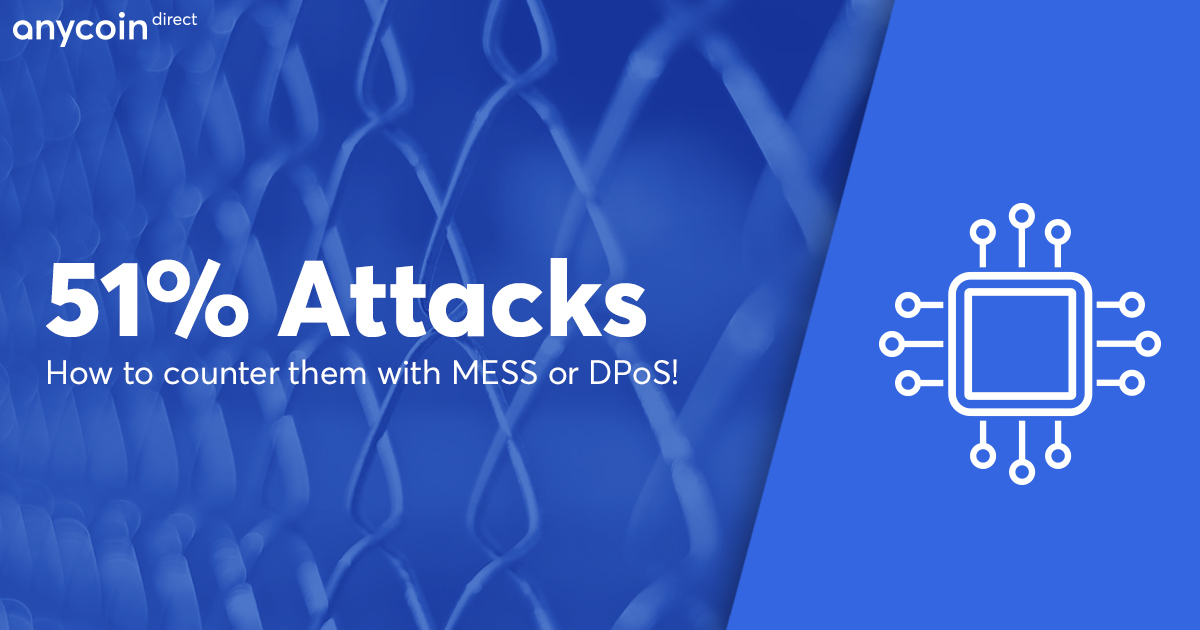51% attacks – How to counter them with MESS or DPoS
- 7 minute read

A few weeks ago we explained what a 51% attack is and highlighted some famous cases throughout crypto history. In today’s article, we are going to take a closer look on how 51% attacks are prevented. Will all future crypto’s benefit from a Delegated-Proof-of-Stake algorithm, or will other solutions such as ETC’s MESS be the solution? Find out in part 2 on 51% attacks.

Refresh
Let’s refresh and look back at what a 51% attack actually is. In our previous article we mentioned that a 51% attack happens when one single entity (person or organization) has control over 51% of a blockchain’s hash rate (computing powers). Because this single entity has the majority of the mining power, the immutable factor is immediately compromised. Suddenly, the majority can change certain rules and can change how nodes verify each other. By going back in the chain, they can ‘reorganize’ the rules and have the majority to do so. In 99,9% of these cases, such an attack is used for theft. By bending the rules, transactions can be double spent, doubling enormous amounts of coins in the process.
Multiple Solutions
So how can they prevent such a 51% attack from happening? There are multiple solutions to that question. The first one is the most commonly used solution, the switch to a Delegated-Proof-of-Stake consensus algorithm. Getting confused on all the different types? We have made a small summary of the three most relevant consensus algorithms:
- Proof of Work (PoW): Miners use their computing power to ‘mine’ the next block. The miners receive rewards for mining the blocks.
- Proof of Stake (PoS): Users validate the next block by ‘staking’ (holding) their coin. The validator of the next block is determined by an algorithm. Hypothetically, each individual user can be chosen as a validator.
- Delegated-Proof-of-Stake (DPoS): Instead of being chosen by an algorithm, multiple delegates are chosen to validate the next block. These delegators are changed from time to time. If a delegate doesn’t contribute, he/she can be booted from the network.
If attackers want to 51% attack a PoW blockchain, they need to take control of 51% off that blockchains computing power. For smaller coins, certain mining pools or mining farms would be able to achieve this. If attackers want to 51% attack a PoS blockchain, they would have to hold 51% of all available coins of that specific currency. Still, not impossible, but certainly less logical or lucrative for the attacker. With a Delegated-Proof-of-Stake 51% attack, the attacker would need to control the delegates in addition to owning 51% of the currency. Even then, all other stakers can take a ‘vote’ and kick out the corrupted delegates. Completing a 51% attack on a Delegated-Proof-of-Stake blockchain is a nigh impossible task.
Alternatives
So every coin should have a Delegated-Proof-of-Stake consensus algorithm right? That might seem logical, but Proof-of-Work is still the more popular variant. DPoS has its own cons, is harder to implement and chosen validators due contrive from the whole ‘decentralized’ essence of cryptocurrency. So what are the alternatives in defense against 51% attacks? One example is ETC's MESS system.
MESS is a solution that makes attacking $ETC upwards of ~31x more expensive, making double-spend and reorg attacks impractical.
— Ethereum Classic (@eth_classic) February 3, 2021
Want to reorg the chain 3000 blocks deep?
Protected by the MESS protocol, it would cost over $20,000,000.
Learn more below.https://t.co/DLBFVKHPvc
A MESSy situation
In 2020, Ethereum Classic suffered three 51% attack. Reports say that the attackers only needed a mining rig (hash power) worth $3.800. To counter these attacks, the community decided that it was time for a change. Based on an older idea of Vitalik Buterin in 2014, Ethereum Classic introduced the MESS system in block 11380000. MESS is an acronym for Modified Exponential Subjective Scoring. What does MESS do? Well, they don’t make 51% attacks impossible, but they sure make them a lot more expensive to pull off.
For a 51% attack to occur, the attackers need to have 51% off the hashing power and basically alter the rules that are set in the blockchain. The rule changes are accepted due to them owning the majority of the votes. For these attacks to happen, they need to go way back in order to ‘reorganize’ the entire structure. MESS basically ranks small chain ‘reorganizations’ as favorable and perfectly normal and large chain ‘reorganizations’ (going back thousands of blocks) as highly suspicious. The more blocks that are needed for the reorganization, the more expensive it becomes. Terry Culver, CEO of ETC Labs had the following to say:
“Nodes aren't designed to distinguish between an attacker chain and an honest mining chain,” he said. “What we've done is we've created a system by which large reorgs need to have greater difficulty.”
Instead of $3.800, the same 51% attack would have cost the attackers approximately 20 million dollars due to the implementation of MESS. With this counteract, Ethereum Classic has effectively eliminated potential 51% attacks. It just wouldn’t be lucrative for the attacker. Either switching to DPoS (which is incredibly hard to pull off) or implementing solutions as MESS, it is clear that the crypto industry is still relatively new and needs to innovate as it finds it way. With new industries, there will always be people who will try to abuse it. With innovation and the community in constant discussion, the crypto scene can be build better, safer and stronger.
Read all you need to know in our 'What is Ethereum Classic?' info page or check out ETC's Medium page.


